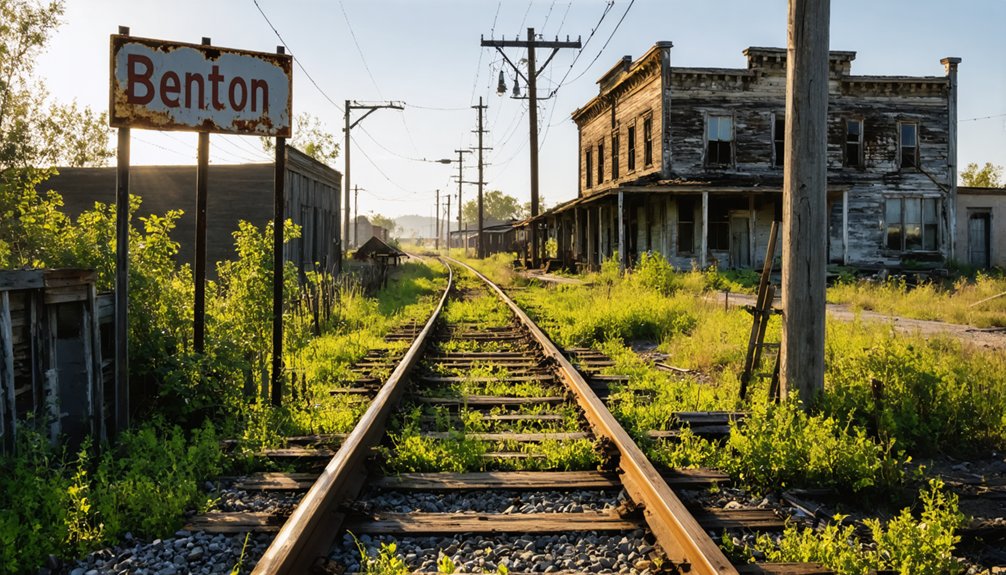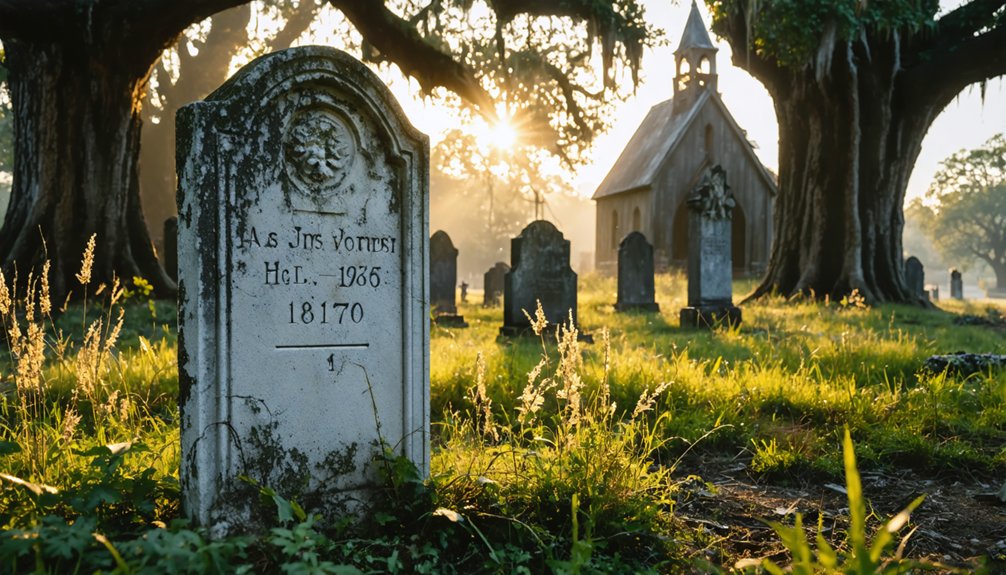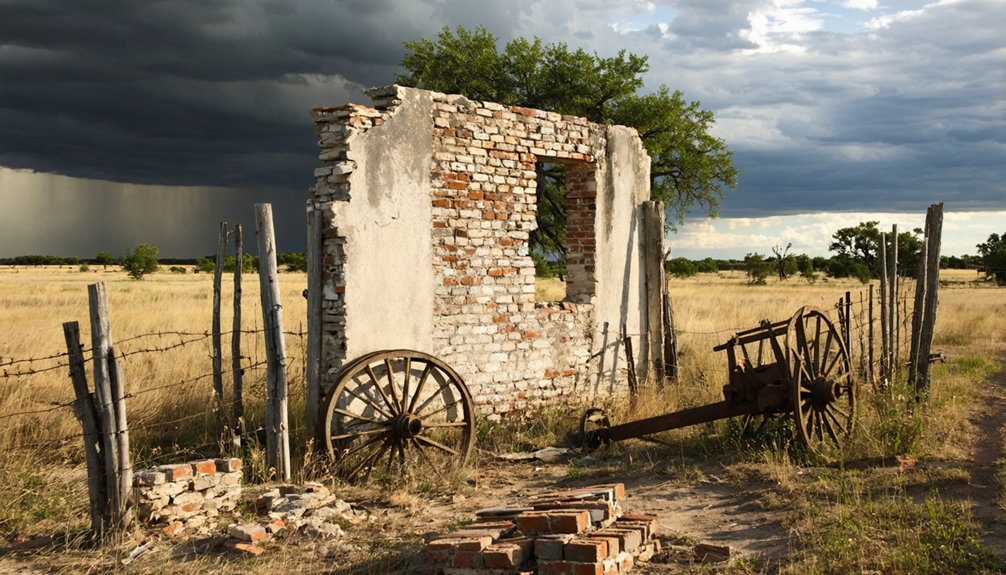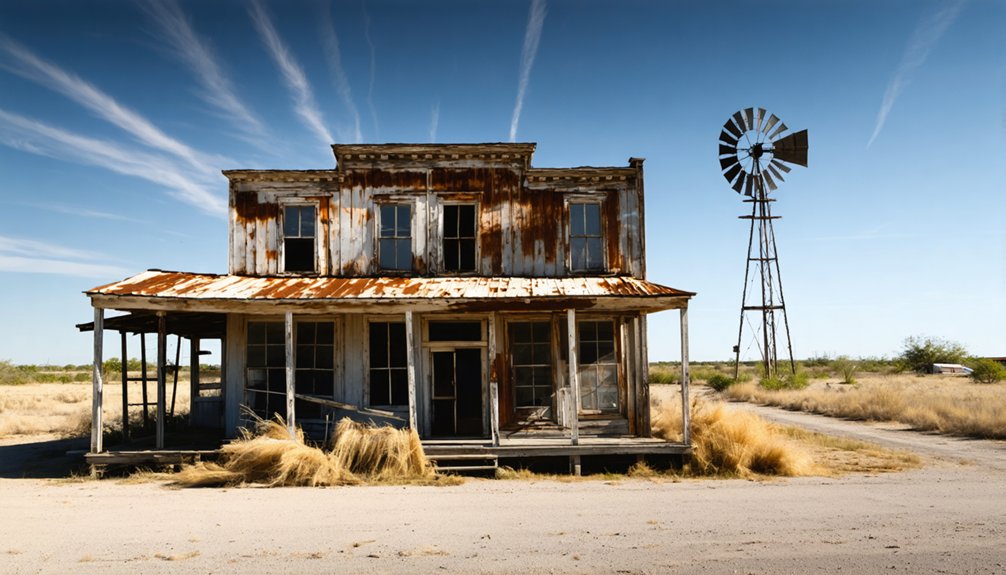You’ll find the ghost town of Benton, Texas along the historic Old San Antonio Road, where it once thrived as a bustling stagecoach stop in the 1870s. The town boasted a prestigious institute, three churches, and a Masonic lodge until the railroad bypassed it in 1881, choosing Temple instead. Today, nature has reclaimed most of Benton’s structures, though scattered ruins still whisper stories of this pioneering settlement’s rise and fall.
Key Takeaways
- Founded in 1876 along the Old San Antonio Road, Benton served as a vital stagecoach stop with multiple mail deliveries weekly.
- The town featured a school (Benton City Institute), three churches, a Masonic lodge, blacksmith shops, and sawmills during its peak.
- Bypassed by the International-Great Northern Railroad in 1881 and Gulf, Colorado and Santa Fe Railway, leading to its economic decline.
- The development of Temple as a major railway hub directly contributed to Benton’s abandonment and transformation into a ghost town.
- Today, only ruins and crumbling structures remain, with the landscape reclaimed by nature, marking the site of this former settlement.
The Birth of a Texas Pioneer Settlement
While many Texas settlements emerged along historic trade routes in the 1840s, Benton City’s establishment along the Old San Antonio Road marked the beginning of a distinctive pioneer community.
You’ll find its namesake traced to either Senator Thomas Hart Benton or Samuel Benton, a Texas Revolution hero, when the town was officially founded in 1876.
As a crucial stagecoach stop receiving mail multiple times weekly, Benton City quickly developed its pioneer infrastructure. To avoid confusion with other locations sharing the name, historical records often refer to it as Benton City, Texas.
The settlement’s growth included essential services like blacksmith shops and sawmills, while churches served the spiritual needs of early settlers.
The crowning achievement of this community development came with the construction of the Benton City Institute in 1875-76, an impressive two-story rock and mortar building that served both as a school and community gathering place. The institute’s distinctive architecture featured yellow rock walls that were built over a foot thick, creating a fortress-like appearance.
Life Along the Old San Antonio Road
As you travel back to Benton’s early days, you’ll find yourself at a critical junction where the Old San Antonio Road intersected with local trade routes, creating a natural stopping point for pioneers and merchants.
You’d have witnessed wagon trains and cattle drives passing through, as travelers took advantage of Benton’s position along this historic thoroughfare that connected Spanish missions from the Sabine River to the Rio Grande. The road supported trade to Saltillo as Spanish ranchers moved their cattle south.
The steady flow of commerce along this 10-to-20-foot-wide trail network helped establish Benton as a transit hub where traders could rest, resupply, and exchange goods with local settlers. The historic route, originally blazed by Spanish explorer Alonso de León in 1691, followed ancient Indian and buffalo trails through the region.
Trade Routes Meet
Since its establishment in the late 17th century, the Old San Antonio Road served as a significant artery where multiple trade routes converged, creating a dynamic network of commerce and cultural exchange.
You’d find the road connecting with critical economic connections like the Upper Presidio Road, Lower Presidio Road, and Camino Pita. At San Antonio, these routes merged into a bustling intersection that linked Texas’s interior to coastal regions and Mexico City via the Chihuahua Road.
You could’ve witnessed diverse traffic flowing through these interconnected pathways – from cattle drives heading to Saltillo’s markets to emigrants seeking new opportunities.
The road’s strategic position made it indispensable for Spanish territorial control, while simultaneously serving as a lifeline for trade goods, military supplies, and agricultural products moving between settlements. Following ancient Aztec trade routes, the road system became vital for connecting Spanish colonial settlements with indigenous communities. This extensive network eventually grew into a 2,500-mile system of interconnected trails with San Antonio at its heart.
Pioneer Transit Hub
The Old San Antonio Road‘s network of trade routes gave rise to vibrant pioneer communities, with Benton emerging as a notable transit hub in the late 1800s.
You’d find essential pioneer transportation services here, from lodging for weary travelers to supply stations serving the surrounding farming settlements. The town’s position along this major thoroughfare made it a natural gathering point for community interactions. By the early 1900s, intercity bus travel became another transportation option connecting Benton to neighboring towns.
As you traveled through Benton, you’d encounter blacksmiths, general stores, and various services catering to both locals and passing pioneers. Local fire departments provided critical emergency response services to protect the growing settlement.
The hub’s significance extended beyond mere transportation – it served as a crucial center for information exchange, postal delivery, and social events.
Churches and schools sprouted nearby, strengthening the community’s identity while fostering cultural exchange between settlers and travelers along the frontier.
Economic Prosperity in the 1880s
During the 1880s, you’d find Benton’s modest economic activity centered around its gristmill-gin operation, which served local agricultural needs and provided essential grain processing for area farmers.
The Masonic lodge became an important gathering place for the community by 1878, providing social and civic connections for residents.
You could observe the town’s small but stable business district anchored by a general store and blacksmith shop, forming the commercial heart of this farming community.
While these enterprises supported Benton’s approximately 50 residents, the town’s growth remained constrained after being bypassed by the International-Great Northern Railroad in 1881, limiting its potential for larger-scale commerce and expansion. This devastating loss of potential railroad access represented a major financial blow that the town would never fully recover from.
Cotton Gins Drive Growth
As cotton gins revolutionized agricultural processing across Texas in the 1880s, Benton’s economy flourished through rapid technological advancement and increased production capacity.
You’d find steam-powered gins replacing horse-driven operations, enabling processing of up to 6 bales daily. These cotton gins became crucial economic hubs, transforming how local farmers managed their harvests.
You could’ve witnessed the efficiency of Munger’s “system” ginning, which introduced continuous feeding mechanisms that dramatically boosted output.
Farmers had flexible options: they could wait on-site, store their cotton for later processing, or arrange for field pickup services. The introduction of wagon scales guaranteed fair transactions, while insurance and cooperative ventures provided stability to your operations.
This technological progress fueled Benton’s growth, creating jobs and generating wealth throughout the community.
Businesses Shape Small Town
While cotton gins drove Benton’s initial growth, diverse businesses transformed this rural outpost into a thriving commercial center by the 1880s.
You’d find bustling mercantile stores stocking everything from farming tools to household goods, while blacksmiths and gristmills supported the agricultural backbone of the community.
The Masonic lodge fostered business networking and community cohesion, creating essential connections among local leaders and merchants.
Education played a significant role too – the Benton City Institute prepared a skilled workforce through courses in law, accounting, and surveying.
Local newspapers kept you informed about market conditions and connected you to regional commerce.
These interconnected businesses created a self-sustaining economy that attracted new settlers and strengthened Benton’s position as a commercial hub.
Daily Life and Community Spirit
From its early days until the mid-1930s, Benton thrived as a close-knit community where daily life revolved around its diverse institutions and gathering places.
You’d find townspeople connecting at three churches, the Masonic lodge, and local stores, forming tight social networks through regular community gatherings.
The Benton City Institute stood as the town’s educational cornerstone, offering not just basic courses but specialized training in law, accounting, and music.
Beyond basic education, the Benton City Institute elevated minds through advanced studies in law, accounting, and musical arts.
Life moved at a steady pace, with mail arriving by stagecoach several times weekly, and residents could tend to their daily needs at the drug store, blacksmith, or carpenter shop.
Churches and the lodge weren’t just places of worship and fellowship – they were the heartbeat of Benton’s vibrant community spirit.
The Railroad’s Impact on Benton

The decision by the Gulf, Colorado and Santa Fe Railway to bypass Benton in favor of Temple proved devastating for the small town’s future.
While nearby Belton had pledged $75,000 to secure railway rights-of-way, the railway company’s decision to route lines elsewhere reshaped the region’s economic landscape.
You’ll find that Temple, starting as just a construction camp in the early 1880s, quickly grew into a major rail hub connecting lines to Galveston, Ft. Worth, and Brownwood.
The railway decisions sealed Benton’s fate.
Even the presence of the Missouri-Kansas-Texas Railroad and the later Belton Railroad’s short line couldn’t prevent the town’s economic decline.
While surrounding communities prospered from rail connections, Benton gradually faded into obscurity, eventually becoming the ghost town you’ll find today.
Legacy of the Benton City Institute
Long before rail lines reshaped Benton’s destiny, education stood as its beating heart through the Benton City Normal Institute.
You’ll find its educational evolution reflected in the change from private tuition to public funding, while its curriculum expanded beyond basics to include law, surveying, and music.
The Institute’s impact reached far beyond classroom walls – you can trace its community impact through the unique partnership with Atascosa Lodge 379, which occupied the building’s top floor until 1909.
Even after becoming the “Old Rock School” in 1910 and later closing in 1919, the Institute’s legacy endures.
Today, its ruins stand as the last evidence to Benton’s vibrant past, symbolizing the pioneering spirit of Texas education and community development.
Stories From the Historic Cemetery

Situated on private land since its 1870 establishment, Benton City Cemetery stands as a silent chronicle of the town’s pioneering spirit.
You’ll find graves of early settler families like the Lytles, Joneses, Calks, and McDonnells, alongside veterans who served in conflicts from Indian warfare to World War II.
The cemetery’s historical significance lies in its detailed record of local life, including victims of an 1800s tuberculosis outbreak that swept through the community.
While cemetery preservation faces challenges due to restricted access and overgrowth, you can still trace the town’s evolution through traditional headstones that mark generations of Texas settlers.
Unlike some of the state’s more tourist-oriented historic cemeteries, Benton City’s graveyard remains authentically untouched, offering a raw glimpse into frontier life.
The Slow Fade Into History
While Benton once thrived as a bustling frontier settlement in the 1870s and 1880s, its decline began when the International-Great Northern Railroad bypassed the town in 1881.
You can trace the community decline through a series of critical changes that slowly drained the town’s liveliness. The transportation evolution from stagecoach to rail left Benton isolated, while neighboring Lytle grew stronger with its railroad connection.
The closure of Benton City Institute in stages between 1919 and 1934 dealt another crushing blow.
You’d have witnessed families relocating for better educational opportunities, businesses shuttering, and social institutions fading away.
What remains today are only ruins and foundations – silent testimonies to a once-prosperous community that couldn’t survive the shifting tides of progress.
What Remains Today

As you stand at the former site of Benton today, you’ll find a stark landscape where nature has largely reclaimed what humans once built. Along Benton City Road, scattered ruined structures tell the story of this abandoned settlement, with most buildings reduced to weathered foundations and skeletal remains.
- Crumbling walls and occasional roofless buildings stand as silent witnesses among native grasses and shrubs.
- Atascosa Creek’s influence has shaped the natural reclamation, creating a wild tapestry across the 731-foot elevation.
- Historic remnants like old fence lines, wells, and road traces outline the original town’s footprint.
You won’t find modern amenities or maintained facilities here – just the raw authenticity of a true Texas ghost town, accessible but untamed, about 27 miles southwest of San Antonio.
Frequently Asked Questions
Can Visitors Legally Explore the Ruins of Benton Today?
You can’t legally explore Benton’s ruins since they’re on private property with unclear ownership. For ghost town exploration and legal access, you’ll need explicit permission from current landowners.
What Happened to the Families Who Originally Lived in Benton?
Like rats fleeing a sinking ship, Benton families scattered when the railroad bypassed their town. You’d find they migrated to Lytle and other nearby communities seeking better schools, jobs, and economic opportunities.
Were There Any Notable Crimes or Outlaws in Benton’s History?
You won’t find any documented outlaw legends or significant crime stories from Benton’s past. Unlike other notorious Texas ghost towns, it operated as a peaceful settlement with typical businesses and community institutions.
Did Native American Tribes Interact With the Benton Settlement?
With over 2,000 Native Americans living on nearby reservations, you’ll find few records of tribal alliances or cultural exchanges since Benton’s 1850 founding came after most tribes were forcibly removed.
What Natural Disasters Affected Benton During Its Active Years?
While you won’t find records of tornado impact or major flood damage, Benton endured periodic droughts, severe thunderstorms, and a devastating tuberculosis outbreak that claimed lives in the late 1800s.
References
- https://www.youtube.com/watch?v=Zd8-gKw-5Hc
- https://en.wikipedia.org/wiki/Benton_City
- https://www.desertedtexas.org/2015/05/benton-texas/
- https://www.youtube.com/watch?v=udY3uBRi0vM
- https://en.wikipedia.org/wiki/List_of_ghost_towns_in_Texas
- https://www.desertedtexas.org/blog/
- https://www.texasescapes.com/SouthTexasTowns/Benton-Texas.htm
- https://www.tshaonline.org/handbook/entries/benton-tx
- https://www.frontiertimesmagazine.com/blog/some-early-bell-county-history-l-a-changer-ritteen-texas
- https://martincitytelegraph.com/2022/08/28/beltons-early-history-is-the-story-of-three-intriguing-pioneers/



